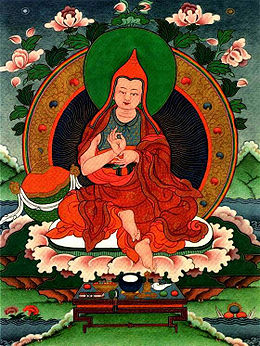Gyalsé Tokmé Zangpo: Difference between revisions
No edit summary |
No edit summary |
||
| (15 intermediate revisions by 4 users not shown) | |||
| Line 1: | Line 1: | ||
'''Gyalsé Ngulchu Tokmé''' or '''Tokmé Zangpo''' ([[Wyl.]] ''thogs med bzang po'') (1297-1371), was born in Puljung, south west of the great [[Sakya | [[Image:Gyalse Thogme Zangpo.jpg|thumb|260px|Gyalse Thogme Zangpo]] | ||
'''Gyalsé Ngulchu Tokmé''' (Tib. རྒྱལ་སྲས་དངུལ་ཆུ་ཐོགས་མེད་, [[Wyl.]] ''rgyal sras dngul chu thogs med'') or '''Tokmé Zangpo''' (ཐོགས་མེད་བཟང་པོ་, [[Wyl.]] ''thogs med bzang po'') (1297-1371), was born in Puljung, south west of the great [[Sakya Monastery]]. He was born in the Wood Sheep year of the fifth [[sexagenary cycle]]. An extremely learned scholar, he studied an infinite number of teachings from all traditions. His every instant was devoted to the [[Dharma]] which he spread through composition, teaching and debate. | |||
He could teach with total confidence on any subject or text. Also, he was able fully to take upon himself the suffering of others and to give them his wellbeing, and without any expectation as to the result, he was extremely generous to all, particularly the poor, the destitute and the suffering. He met [[buddha]]s and deities such as [[Avalokiteshvara]] and [[Tara]] face to face. He taught many of the greatest teachers of his time in Central Tibet, such as Khenchen Lochen Changchup Tsemo (1303-1380), [[Butön Rinchen Drup]] (1290-1364), great [[Sakya]] masters and so on. He was served as abbott at the [[Bodong]] E monastery. He passed away at the age of 74 amidst wondrous signs of realization. | |||
==His Writings== | |||
*''[[Thirty-Seven Practices of the Bodhisattvas]]'' - the famous text on bodhichitta. | |||
:{{LH|topics/lojong/37-practices-all-bodhisattvas|''Thirty Seven Practices of All Bodhisattvas'' by Gyalsé Thokmé Zangpo}} (Lotsawa House) | |||
*''[[Ocean of Good Explanation]]'' - a commentary on the ''[[Bodhicharyavatara]]'', which [[Patrul Rinpoche]] would often take as a basis for teaching the text. | |||
*{{LH|topics/lojong/how-transform-sickness|''How to Transform Sickness and Other Circumstances''}} | |||
==Further Reading== | |||
*For a more extensive biography see ''The Heart of Compassion'', by [[Dilgo Khyentse Rinpoche]], Shambhala Publications, 2007, pp.11-26, and see p.232 for a list of his works. | *For a more extensive biography see ''The Heart of Compassion'', by [[Dilgo Khyentse Rinpoche]], Shambhala Publications, 2007, pp.11-26, and see p.232 for a list of his works. | ||
==External Links== | |||
*{{TBRC|P1830|TBRC Profile}} | |||
*[https://treasuryoflives.org/biographies/view/Gyelse-Tokme-Zangpo/3153 Biography at Treasury of Lives] | |||
[[Category: Historical Masters]] | [[Category: Historical Masters]] | ||
[[Category:Kadampa Masters]] | |||
Latest revision as of 06:16, 29 May 2018

Gyalsé Ngulchu Tokmé (Tib. རྒྱལ་སྲས་དངུལ་ཆུ་ཐོགས་མེད་, Wyl. rgyal sras dngul chu thogs med) or Tokmé Zangpo (ཐོགས་མེད་བཟང་པོ་, Wyl. thogs med bzang po) (1297-1371), was born in Puljung, south west of the great Sakya Monastery. He was born in the Wood Sheep year of the fifth sexagenary cycle. An extremely learned scholar, he studied an infinite number of teachings from all traditions. His every instant was devoted to the Dharma which he spread through composition, teaching and debate.
He could teach with total confidence on any subject or text. Also, he was able fully to take upon himself the suffering of others and to give them his wellbeing, and without any expectation as to the result, he was extremely generous to all, particularly the poor, the destitute and the suffering. He met buddhas and deities such as Avalokiteshvara and Tara face to face. He taught many of the greatest teachers of his time in Central Tibet, such as Khenchen Lochen Changchup Tsemo (1303-1380), Butön Rinchen Drup (1290-1364), great Sakya masters and so on. He was served as abbott at the Bodong E monastery. He passed away at the age of 74 amidst wondrous signs of realization.
His Writings
- Thirty-Seven Practices of the Bodhisattvas - the famous text on bodhichitta.
- Ocean of Good Explanation - a commentary on the Bodhicharyavatara, which Patrul Rinpoche would often take as a basis for teaching the text.
 How to Transform Sickness and Other Circumstances
How to Transform Sickness and Other Circumstances
Further Reading
- For a more extensive biography see The Heart of Compassion, by Dilgo Khyentse Rinpoche, Shambhala Publications, 2007, pp.11-26, and see p.232 for a list of his works.